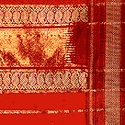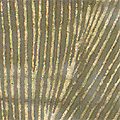
Saris/Unstitched Garments, Textiles, Weaving, Spinning, Khadi
Kanchipuram Silk Sari Weaving of Tamil Nadu
Kanchipuram is the famous weaving centre in Tamil Nadu. The weaving community in Kanchipuram is called Salgars (from the Sanskrit word, salika meaning weaver), and they claim descent from Sage Markanda, the weaver of the gods. Earlier the design-jacquards were made from round lamp-wicks but now mechanised hooks and jacquard boxes are used. The designs on the body of the sari are woven with gold thread and the motifs range from figures to temple gopuras (towers) along the border. One of the traditions of the Kanchipuram saris is the contrasting borders.
Two weavers work on three shuttles to make the sari; the pallu is also done separately, especially if it is of another shade. The meeting of the body of the sari with the border is characterised by a zigzag design, the vanki design, which can also be found all over the body. Typical motifs used in these saris are the sun, moon, chariots, swans, peacocks, parrots, lions, coins, mangoes and leaves. Patterns are also formed by lines and squares and when the jasmine motif is found either inside a square or scattered all over, it is called mallinaggu. The Thandavalam motif has parallel-line motifs running all over the body of the sari. In the pattu motif, the pallu and the border alone have floral motifs independently woven on them. Other motifs used are creepers, peacocks and the rudraksh or red-dented seed pattern on the body and end-borders of the sari.
These saris are usually made in brilliant reds, saffron, orange, emerald, henna green, maroon, peacock blue and ochre with bright contrasting borders. These days silver is being used in addition to gold. Weavers also make tissue saris, using only gold or silver metal threads. This tradition of silk sari weaving at Kanchipuram arose out of temple-traditions with the famous Kamakshi temple situated there. Upper-caste families wore only silk and weddings and festivals (Deepavali, Pongal, etc) were an occasion for the purchase of many silk saris.
Gallery
YOUR VIEWS
PRACTITIONERS: INDIA
Access 70,000+ practitioners in 2500+ crafts across India.
BIBLIOGRAPHY
10,000+ listings on arts, crafts, design, heritage, culture etc.
GLOSSARY
Rich and often unfamiliar vocabulary of crafts and textiles.
SHOP at India InCH
Needs to be written.





